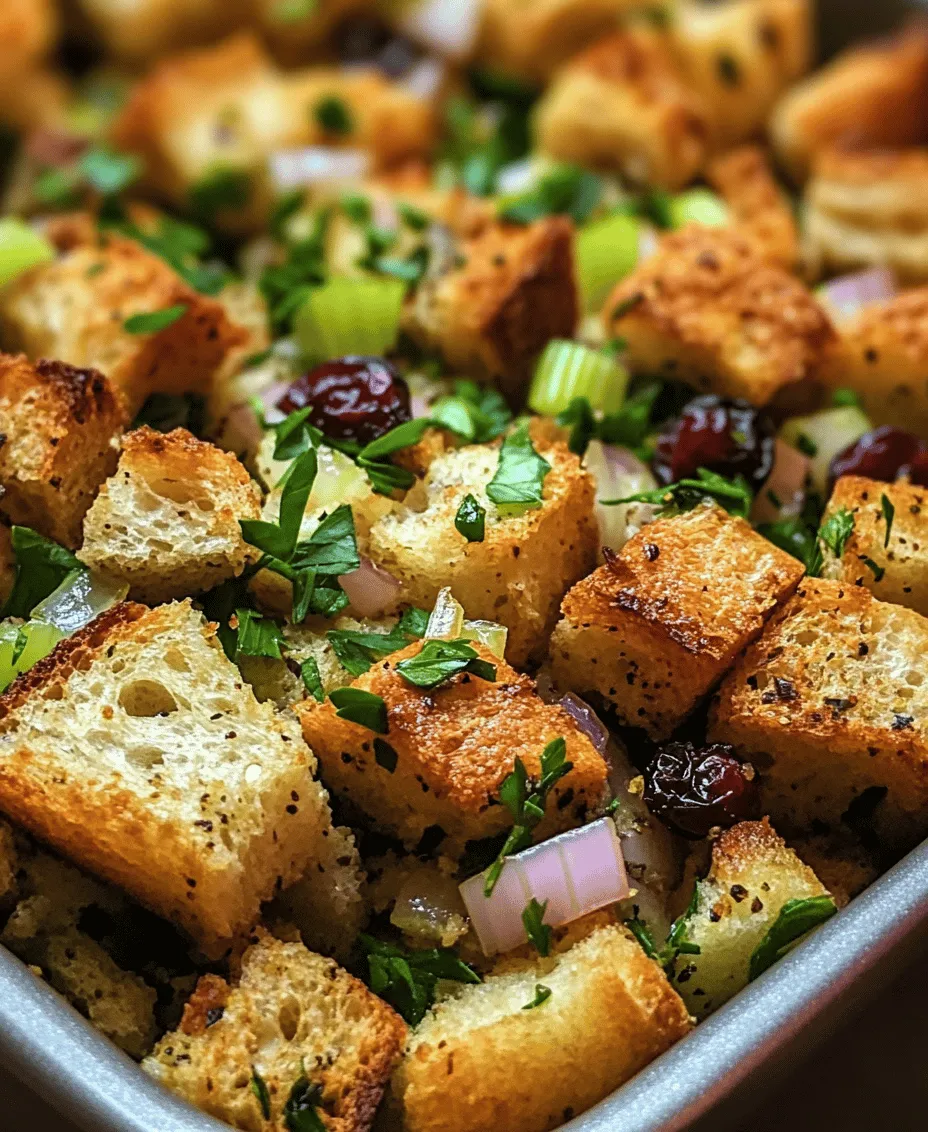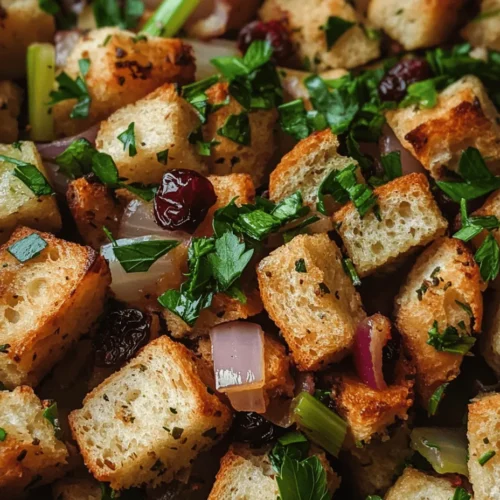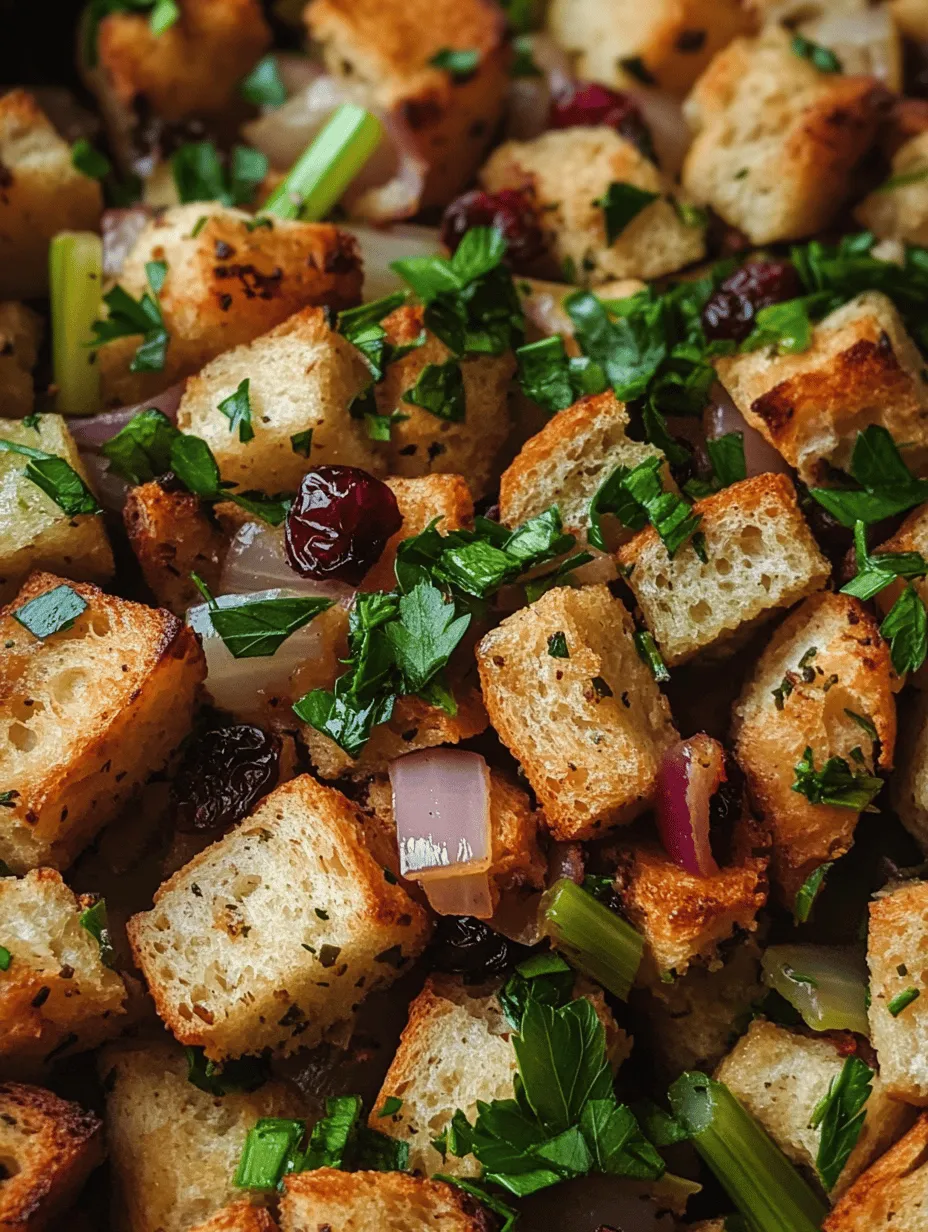Stuffing has long been a cherished component of festive meals, infusing gatherings with warmth and flavor. From Thanksgiving dinners in the United States to holiday feasts across Europe, stuffing serves as a comforting and satisfying side dish that complements the main course. Among the myriad of stuffing variations, Savory Herb and Cranberry Bread Stuffing stands out with its unique flavor profile, combining earthy herbs with the subtle sweetness of cranberries. This delightful stuffing is not only easy to prepare but also versatile, making it a perfect addition to any holiday table or family dinner.
Understanding Stuffing: A Culinary Tradition
The tradition of stuffing dates back centuries, with origins rooted in various cultures around the world. Historically, stuffing was used as a way to stretch limited resources, allowing cooks to make the most of leftover bread and vegetables. In ancient Rome, for instance, recipes for stuffing included a variety of grains and meats, often seasoned with herbs and spices. As culinary practices evolved, stuffing recipes adapted to regional ingredients and cultural influences, resulting in diverse variations that reflect local flavors.
In the United States, stuffing became synonymous with Thanksgiving, often made with cornbread or white bread, seasoned with sage and onions, and cooked either inside the turkey or separately. However, modern adaptations have expanded the scope of stuffing, incorporating ingredients like fruit, nuts, and a variety of herbs. The Savory Herb and Cranberry Bread Stuffing exemplifies this evolution, marrying the traditional with a contemporary twist. By introducing dried cranberries and a medley of fresh herbs, this stuffing boasts a delightful balance of flavors that enhances the overall dining experience.
Ingredients Breakdown for Savory Herb and Cranberry Bread Stuffing
To create a delicious Savory Herb and Cranberry Bread Stuffing, it’s essential to select high-quality ingredients that contribute to both flavor and texture. Below is a breakdown of the key components that make this recipe a standout.
Rustic Bread
At the heart of any good stuffing is the bread. Choosing the right type of bread is crucial, as it serves as the foundation for the dish. For this recipe, rustic bread such as sourdough, ciabatta, or a hearty whole grain works best. The crusty exterior and dense texture of these breads allow them to absorb the broth without becoming mushy. When selecting bread, opt for day-old or stale varieties, as they will hold their shape better when mixed with the other ingredients.
Unsalted Butter
Unsalted butter plays a vital role in enhancing the flavor and moisture of the stuffing. By sautéing the vegetables in butter, you not only build a rich flavor base but also add a luxurious mouthfeel to the final dish. Using unsalted butter allows you to control the saltiness of the stuffing, ensuring it remains balanced and flavorful.
Vegetables
A mixture of aromatic vegetables forms the flavor base of this stuffing. Onions, celery, and garlic are classic choices that bring depth and richness to the dish. When sautéed in butter, these vegetables release their natural sweetness and create a fragrant foundation that complements the other ingredients. The key is to chop the vegetables into uniform pieces to ensure even cooking and distribution throughout the stuffing.
Dried Cranberries
Dried cranberries add a delightful contrast to the savory elements of the stuffing. Their natural sweetness balances the richness of the butter and the earthiness of the herbs, creating a harmonious flavor profile. In addition to their taste, cranberries contribute a beautiful pop of color that enhances the visual appeal of the dish. When incorporating cranberries, be sure to choose high-quality, unsweetened varieties to maintain the stuffing’s savory character.
Fresh Herbs
The use of fresh herbs is essential in elevating the flavor of the Savory Herb and Cranberry Bread Stuffing. Fresh parsley, thyme, rosemary, and sage provide aromatic notes that brighten the dish. While dried herbs can be used in a pinch, fresh herbs deliver a more vibrant flavor and a fragrant aroma. When preparing the stuffing, chop the fresh herbs finely to ensure their essence permeates throughout the mixture.
Broth and Eggs
Broth serves as the binding agent for the stuffing, providing moisture and flavor. Chicken or vegetable broth can be used, depending on dietary preferences. The key is to add enough broth to hydrate the bread while maintaining a cohesive texture. Additionally, eggs act as a binder, helping to hold the stuffing together and providing a slight richness.
Seasoning
Finally, seasoning with salt and pepper is essential for enhancing the overall taste of the stuffing. The right amount of seasoning brings out the flavors of each ingredient, creating a well-rounded dish. Be mindful of the sodium content in the broth and butter when adding salt, and taste the mixture before baking to ensure it meets your flavor preference.
By carefully selecting and preparing these ingredients, you will create a Savory Herb and Cranberry Bread Stuffing that is not only delicious but also embodies the spirit of festive gatherings. With its ease of preparation and adaptability, this stuffing recipe is sure to become a beloved addition to your culinary repertoire.
Initial Steps for Preparation
To prepare your Savory Herb and Cranberry Bread Stuffing, follow these initial steps that will set the foundation for a mouthwatering dish.
1. Preheat the Oven: Start by preheating your oven to 350°F (175°C). This will ensure that your stuffing bakes evenly and achieves a golden-brown crust.
2. Prepare the Bread: Cut the rustic bread into 1-inch cubes and spread them out on a baking sheet. Allow the bread to dry out in the oven for about 10-15 minutes. This step is crucial, as it helps the bread absorb the broth without turning soggy.
3. Sauté the Vegetables: In a large skillet, melt unsalted butter over medium heat. Add the chopped onions, celery, and minced garlic, sautéing until the vegetables are soft and translucent, about 5-7 minutes. The aroma that fills your kitchen at this stage is just the beginning of the flavor journey.
4. Mix the Ingredients: In a large mixing bowl, combine the toasted bread cubes, sautéed vegetables, dried cranberries, and finely chopped fresh herbs. Toss the mixture gently to distribute the ingredients evenly.
5. Add Broth and Eggs: In a separate bowl, whisk together the broth and eggs. Gradually pour this mixture over the bread and vegetable blend, gently folding it in. Make sure the bread is thoroughly moistened but not overly soaked. You want the stuffing to hold together while still retaining a bit of texture.
These initial steps pave the way for the full preparation of your Savory Herb and Cranberry Bread Stuffing, ensuring that each bite is bursting with flavor and perfectly balanced. As you continue through the recipe, you’ll discover how easy it is to create a dish that not only enhances your holiday meals but also delights your family and friends.

Step-by-Step Instructions for Preparation
Preparing the Bread
The foundation of any great stuffing is the bread, and the type you choose can significantly impact the final dish. For this Savory Herb and Cranberry Bread Stuffing, a mix of rustic bread, such as sourdough or a crusty baguette, yields excellent results. Begin by cutting the bread into 1-inch cubes—this allows for even distribution of flavors and texture.
Toasting the bread cubes is crucial for developing flavor and achieving the desired texture. Preheat your oven to 350°F (175°C) and spread the bread cubes in a single layer on a baking sheet. Bake for about 10-15 minutes or until they are golden brown and slightly crisp. This step not only enhances the flavor but also prevents the bread from becoming mushy when combined with the broth later.
Sautéing Vegetables
While your bread is toasting, it’s time to sauté the vegetables. This step is essential for building the aromatic base of your stuffing. In a large skillet, melt 1/2 cup of unsalted butter over medium heat. Add 1 cup of diced onion, 1 cup of chopped celery, and 1 cup of diced carrots. Sauté these vegetables for about 10-12 minutes, stirring occasionally, until they are tender and translucent.
For an added depth of flavor, consider incorporating minced garlic and a pinch of salt about halfway through the sautéing process. The key here is to ensure that the vegetables are soft but not browned, as you want to preserve their fresh and vibrant flavors that will complement the stuffing.
Mixing Ingredients
Once your bread is toasted and vegetables are sautéed, it’s time to bring everything together. In a large mixing bowl, combine the toasted bread cubes with the sautéed vegetable mixture. Gently toss the ingredients to ensure even distribution without breaking the bread too much.
Next, add 1 cup of dried cranberries and 1/2 cup of chopped fresh herbs, such as parsley, sage, and thyme. These ingredients will add a delightful sweetness and freshness to your stuffing. To enhance the flavor even further, consider sprinkling in some salt and pepper, adjusting to your taste preferences.
Incorporating Broth and Eggs
To achieve the ideal consistency for your stuffing, you’ll need to incorporate the broth and eggs carefully. In a separate bowl, whisk together 2 cups of vegetable or chicken broth (depending on your preference) and 2 large eggs. The eggs serve as a binding agent, helping the stuffing hold its shape during baking.
Gradually pour the broth mixture over the bread and vegetable mixture, using a spatula to gently fold the ingredients together. Be careful not to overmix—you’re aiming for a moist stuffing that holds together but is still fluffy. If the mixture seems too dry, add a little more broth, one tablespoon at a time, until you reach your desired consistency.
Baking the Stuffing
Preheat your oven to 375°F (190°C) for baking. Transfer the stuffing mixture into a greased baking dish, spreading it evenly. For a crispy top, consider drizzling a bit of melted butter over the surface before placing it in the oven.
Bake the stuffing uncovered for about 25-30 minutes, or until the top is golden brown and crispy while the inside remains moist. For an extra layer of texture, you can broil it for the last few minutes of baking—just keep a close eye to prevent burning.
Serving Suggestions
Once your Savory Herb and Cranberry Bread Stuffing is out of the oven, it’s time to serve it up! This stuffing pairs beautifully with roasted turkey or chicken, making it a perfect addition to your holiday feast. To elevate the presentation, consider serving the stuffing family-style in a large, attractive dish, garnished with fresh herbs for a pop of color.
For an even more festive touch, you can create individual portions by scooping the stuffing into small ramekins before baking. This not only enhances the visual appeal but also allows guests to have their own serving, which is both practical and charming.
Nutritional Information
When considering the nutritional content of your Savory Herb and Cranberry Bread Stuffing, it’s worth noting that one serving (approximately 1 cup) typically contains around 250 calories, 10 grams of fat, 35 grams of carbohydrates, and 6 grams of protein. The inclusion of cranberries offers a boost of antioxidants and fiber, while the vegetables provide essential vitamins and minerals.
For those with dietary restrictions, this stuffing recipe can easily be adapted. To make it vegetarian-friendly, simply use vegetable broth instead of chicken broth. If you’re catering to gluten-free guests, consider using gluten-free bread as a substitute for traditional bread, ensuring that everyone can enjoy this delicious stuffing.
Creative Variations and Adaptations
While the classic Savory Herb and Cranberry Bread Stuffing is a holiday favorite, there are countless ways to customize it to suit your tastes. Here are a few creative variations:
– Nuts and Seeds: For a delightful crunch, consider adding 1/2 cup of chopped nuts such as pecans or walnuts. Toast them lightly before mixing them in to enhance their flavor.
– Different Dried Fruits: While cranberries are a fantastic choice, you could also experiment with other dried fruits like apricots, cherries, or raisins. Each will lend a unique flavor profile to your stuffing.
– Alternative Breads: Experimenting with different types of bread can also yield interesting results. Consider using cornbread for a Southern twist or brioche for a rich and buttery stuffing.
– Dietary Needs: For those looking for gluten-free options, using gluten-free bread as a base and ensuring your broth is also gluten-free will make this stuffing accessible to all. For vegan adaptations, replace eggs with flaxseed meal or chia seeds mixed with water as a binding agent, and use vegetable broth as the base.
Conclusion
The Savory Herb and Cranberry Bread Stuffing is more than just a side dish; it’s a beloved holiday staple that brings warmth and joy to festive gatherings. Its combination of toasted bread, aromatic herbs, and sweet cranberries creates a delightful medley of flavors and textures that enhance any meal.
As you gather with friends and family, take the time to enjoy the process of creating homemade dishes that resonate with tradition and love. This stuffing recipe not only showcases your culinary skills but also provides the opportunity to personalize your holiday experience. Feel free to explore your creativity, adding unique touches that reflect your family’s preferences and create lasting memories around the dining table. Happy cooking!


